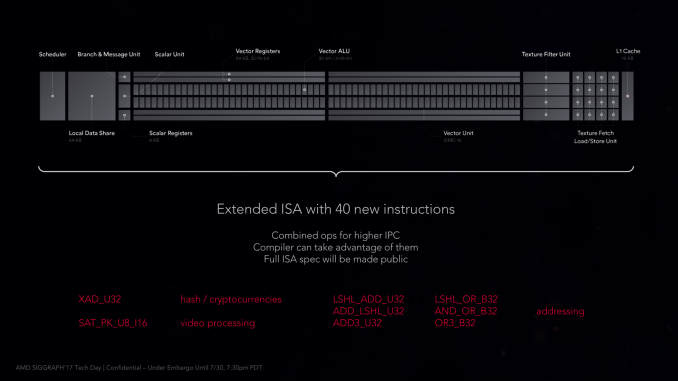The AMD Radeon RX Vega 64 & RX Vega 56 Review: Vega Burning Bright
by Ryan Smith & Nate Oh on August 14, 2017 9:00 AM ESTThe Vega Architecture: AMD’s Brightest Day
From an architectural standpoint, AMD’s engineers consider the Vega architecture to be their most sweeping architectural change in five years. And looking over everything that has been added to the architecture, it’s easy to see why. In terms of core graphics/compute features, Vega introduces more than any other iteration of GCN before it.
Speaking of GCN, before getting too deep here, it’s interesting to note that at least publicly, AMD is shying away from the Graphics Core Next name. GCN doesn’t appear anywhere in AMD’s whitepaper, while in programmers’ documents such as the shader ISA, the name is still present. But at least for the purposes of public discussion, rather than using the term GCN 5, AMD is consistently calling it the Vega architecture. Though make no mistake, this is still very much GCN, so AMD’s basic GPU execution model remains.
So what does Vega bring to the table? Back in January we got what has turned out to be a fairly extensive high-level overview of Vega’s main architectural improvements. In a nutshell, Vega is:
- Higher clocks
- Double rate FP16 math (Rapid Packed Math)
- HBM2
- New memory page management for the high-bandwidth cache controller
- Tiled rasterization (Draw Stream Binning Rasterizer)
- Increased ROP efficiency via L2 cache
- Improved geometry engine
- Primitive shading for even faster triangle culling
- Direct3D feature level 12_1 graphics features
- Improved display controllers
The interesting thing is that even with this significant number of changes, the Vega ISA is not a complete departure from the GCN4 ISA. AMD has added a number of new instructions – mostly for FP16 operations – along with some additional instructions that they expect to improve performance for video processing and some 8-bit integer operations, but nothing that radically upends Vega from earlier ISAs. So in terms of compute, Vega is still very comparable to Polaris and Fiji in terms of how data moves through the GPU.
Consequently, the burning question I think many will ask is if the effective compute IPC is significantly higher than Fiji, and the answer is no. AMD has actually taken significant pains to keep the throughput latency of a CU at 4 cycles (4 stages deep), however strictly speaking, existing code isn’t going to run any faster on Vega than earlier architectures. In order to wring the most out of Vega’s new CUs, you need to take advantage of the new compute features. Note that this doesn’t mean that compilers can’t take advantage of them on their own, but especially with the datatype matters, it’s important that code be designed for lower precision datatypes to begin with.











213 Comments
View All Comments
TheinsanegamerN - Monday, August 14, 2017 - link
Enough AMD fans will buy at inflated prices to make AMD some cold hard cash, then they will lower the price in 3 months.Aldaris - Monday, August 14, 2017 - link
It's still a competitor against the 1080.mapesdhs - Monday, August 14, 2017 - link
Not when it costs 100 UKP more (UK pricing). If the US pricing is as claimed, then I guess it's down to how much one cares about power/noise.xfrgtr - Tuesday, August 15, 2017 - link
the 64 does very poorly against the 1080darkfalz - Monday, August 14, 2017 - link
Not really. The x70 is usually 75% the performance of the x80. 25% is nothing to baulk at even if the price premium is much more than 25%.The 56 is something like 85-90% as fast as the 64 and significantly cheaper.
It's a shame this GPU arch is essentially DOA. Makes the wait for Volta much longer. Then again my 1080 is still giving me great performance and I'm CPU limited a lot at 1440p.
mapesdhs - Monday, August 14, 2017 - link
I think you're right, this will give NV more time to refine Volta, it'll sustain 10x0 sales for longer, so we'll have to wait for something better for those who want to move beyond the current 10x0 series.Da W - Monday, August 14, 2017 - link
Ryzen, Vega, Infinity fabric. The stage is set for a new fusion. Can't wait to see what their top 4-core + iGPU can do as a streamer box.tipoo - Monday, August 14, 2017 - link
It's surprising there still isn't even an APU as powerful as the PS4s GPU yet.Qwertilot - Monday, August 14, 2017 - link
They have, alas, no R&D money for that sort of 'side' project.msroadkill612 - Monday, August 14, 2017 - link
I hear nothing but good from folks who actually use amdS apuS appropriately. The 7850k was a classic for the money.Importantly, they have remained in the apu biz all along, and have the unique skillset to competently execute a new gen apu.
I wouldnt call mobile ryzen a side project. Its a cornerstone.